fuel filter MAZDA PROTEGE 1992 User Guide
[x] Cancel search | Manufacturer: MAZDA, Model Year: 1992, Model line: PROTEGE, Model: MAZDA PROTEGE 1992Pages: 1164, PDF Size: 81.9 MB
Page 326 of 1164
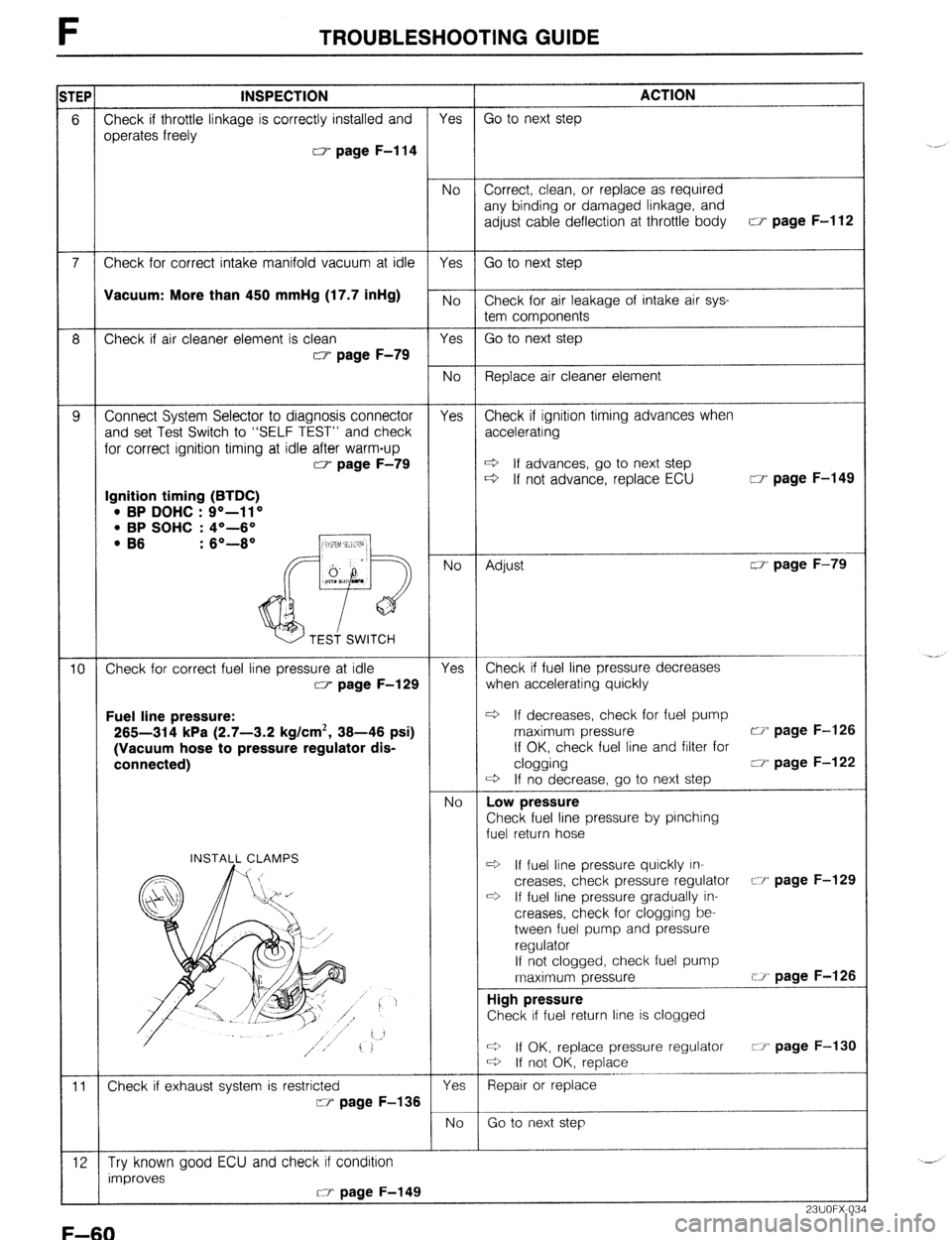
F TROUBLESHOOTING GUIDE
TEP INSPECTION ACTION
6 Check if throttle linkage is correctly installed and Yes Go to next step
operates freely
w page F-l 14
No Correct, clean, or replace as required
any binding or damaged linkage, and
adjust cable deflection at throttle body CT page F-l 12
7 Check for correct intake manifold vacuum at idle Yes Go to next step
Vacuum: More than 450 mmHg (17.7 intig) -
No
Check for air leakage of intake air sys-
tem components
8 Check if air cleaner element is clean Yes Go to next step
w page F-79
No Replace air cleaner element
9 Connect System Selector to diagnosis connector Yes Check if ignition timing advances when
and set Test Switch to “SELF TEST” and check accelerating
for correct ignition timing at idle after warm-up
w page F-79 c3 If advances, go to next step
c3 If not advance, replace ECU [II page F-149
Ignition timing (BTDC)
l BP DOHC : Q”-1 1 o l BP SOHC : 4O-6’
’ B6 : 6O-8O
No Adjust CT+ page F-79
10 Check for correct fuel line pressure at idle Yes Check if fuel line pressure decreases
w page F-129 when accelerating quickly
Fuel line pressure: c3 If decreases, check for fuel pump
265-314 kPa (2.7-3.2 kg/cm*, 38-46 psi) maximum pressure w page F-126
(Vacuum hose to pressure regulator dis- If OK, check fuel line and filter for
connected) clogging CI,’ page F-122
+ If no decrease, go to next step
-
No Low pressure
Check fuel line pressure by pinching
fuel return hose
cti If fuel line pressure quickly In-
creases, check pressure regulator CT page F-129
ti If fuel line pressure gradually in-
creases, check for clogging be-
tween fuel pump and pressure
regulator
If not clogged, check fuel pump
maximum pressure cr page F-126
-
High pressure
Check if fuel return line is clogged
Q If OK, replace pressure regulator C-Y- page F-130
+ If not OK, replace
--_I. 1”1-~~-~~
11 Check if exhaust system is restricted Yes Repair or replace
C-T- page F-136
No Go to next step
12 Try known good ECU and check if condition
improves
CT page F-149
23UOFX-034
F-60
Page 328 of 1164
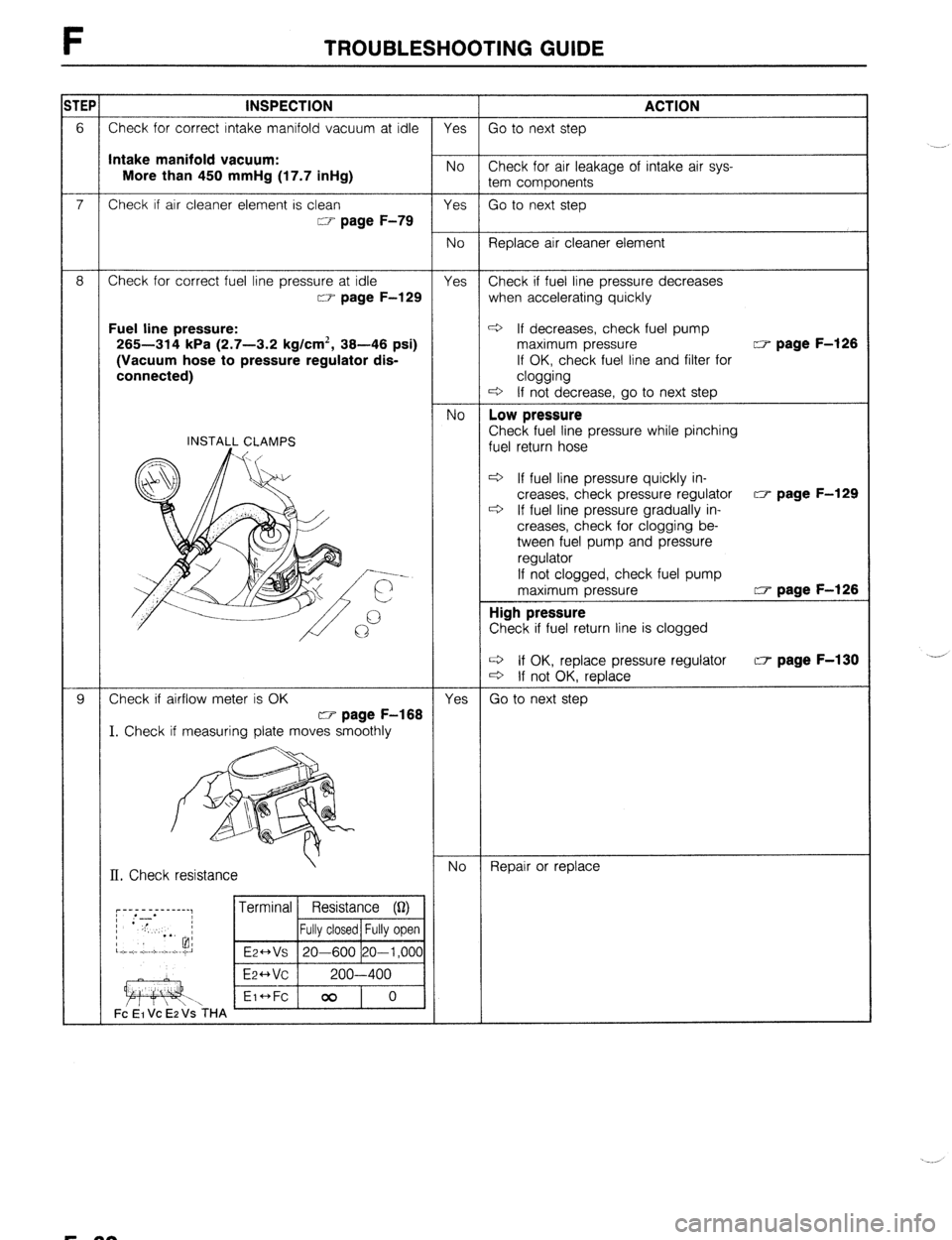
F TROUBLESHOOTING GUIDE
ITEP
INSPECTION ACTION
6 Check for correct intake manifold vacuum at idle Yes Go to next step
Intake manifold vacuum:
More than 450 mmHg (17.7 inHg) No Check for air leakage of intake air sys-
tem components
7 Check if air cleaner element is clean Yes Go to next step
w page F-79
No Replace air cleaner element
8 Check for correct fuel line pressure at idle Yes Check if fuel line pressure decreases
CT= page F-129 when accelerating quickly
Fuel line pressure: c3 If decreases, check fuel pump
265-314 kPa (2.7-3.2 kg/cm’, 38-46 psi) maximum pressure w page F-126
(Vacuum hose to pressure regulator dis- If OK, check fuel line and filter for
connected) clogging
ti If not decrease, go to next step
No Low pressure
INSTALL CLAMPS Check fuel line pressure while pinching
fuel return hose
9 If fuel line pressure quickly in-
creases, check pressure regulator w page F-129
c3 If fuel line pressure gradually in-
creases, check for clogging be-
tween fuel pump and pressure
regulator
If not clogged, check fuel pump
maximum pressure w page F-126
High pressure
Check if fuel return line is clogged
c3 If OK, replace pressure regulator CT page F-130
d If not OK, replace
9 Check if airflow meter is OK
Yes Go to next step
w page F-188
I. Check if measurin late moves smoothly
II. Check resistance No Repair or replace
F-62
Page 332 of 1164
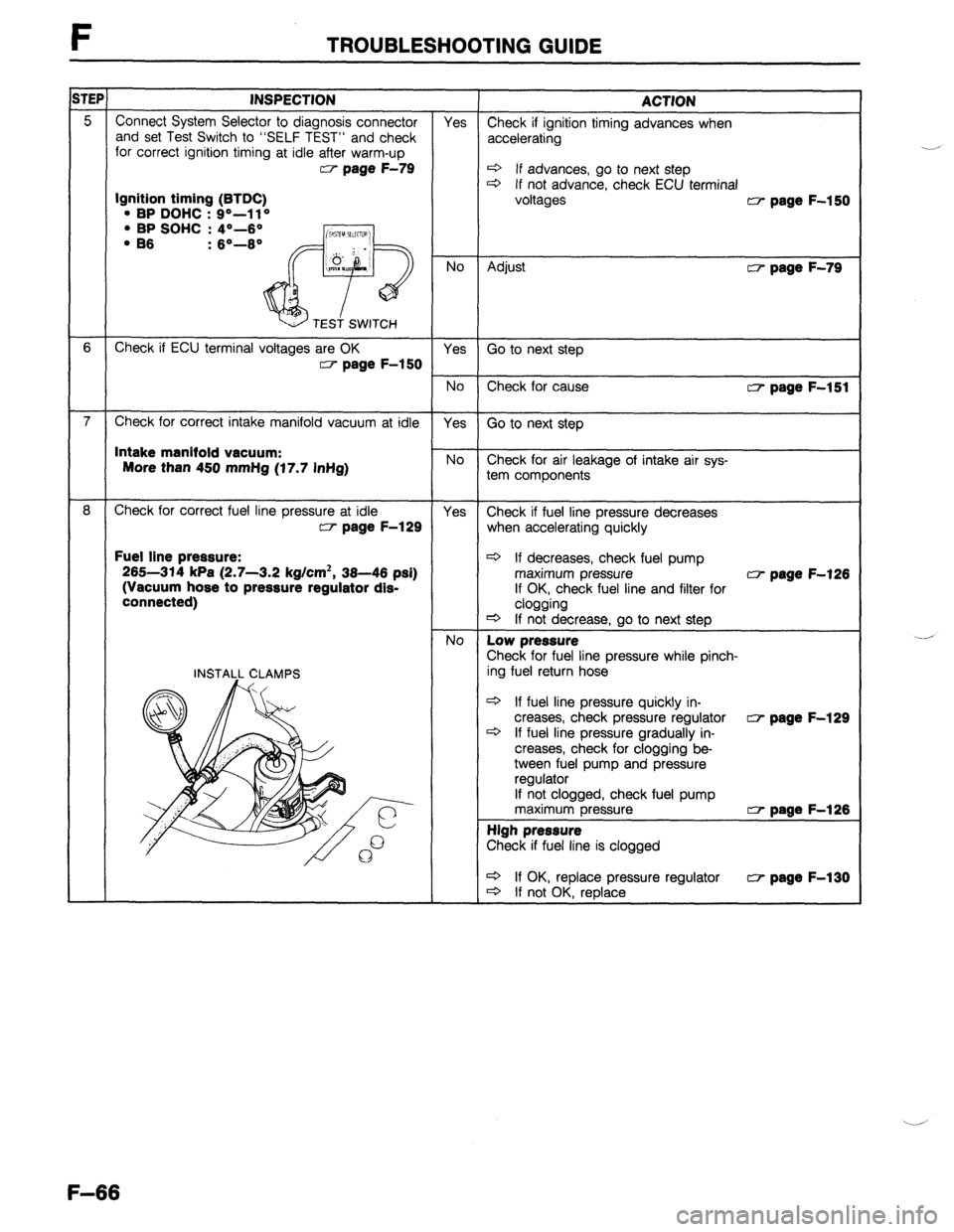
iTEP INSPECTION ACTION
5 Connect System Selector to diagnosis connector Yes
and set Test Switch to “SELF TEST” and check Check if ignition timing advances when
for correct ignition timing at idle after warm-up accelerating w page F-79
* If advances, go to next step
r3 If not advance, check ECU terminal Ignition timing (BTDC)
voltages l BP DOHC : go--ll” w page F-150 l BP SOHC : 4O-6O
. B6 : 6O-6O
No
Adjust w page F-79
6
Check if ECU terminal voltages are OK
Yes Go to next step w page F-150
No
Check for cause ~7 page F-151
7
Check for correct intake manifold vacuum at idle
Yes Go to next step Intake manifold vacuum:
More than 450 mmHg (17.7 inHg) No
Check for air leakage of intake air sys-
tem components
8 Check for correct fuel line pressure at idle
Yes Check if fuel line pressure decreases w page F-129
when accelerating quickly Fuel line pressure:
265-314 kPa (2.7-3.2 kg/cm’, 39-46 psi)
(Vacuum hose to pressure regulator dls-
connected)
d If decreases, check fuel pump
maximum pressure (3‘ page F-126
If OK, check fuel line and filter for
clogging
* If not decrease, go to next step
No Low pressure
Check for fuel line pressure while pinch-
ing fuel return hose
c3 If fuel line pressure quickly in-
creases, check pressure regulator w page F-129
+ If fuel line pressure gradually in-
creases, check for clogging be-
tween fuel pump and pressure
regulator
If not clogged, check fuel pump
maximum pressure w page F-126
High pressure
Check if fuel line is clogged
* If OK, replace pressure regulator w page F-130
c3 If not OK, replace
F-66
Page 386 of 1164
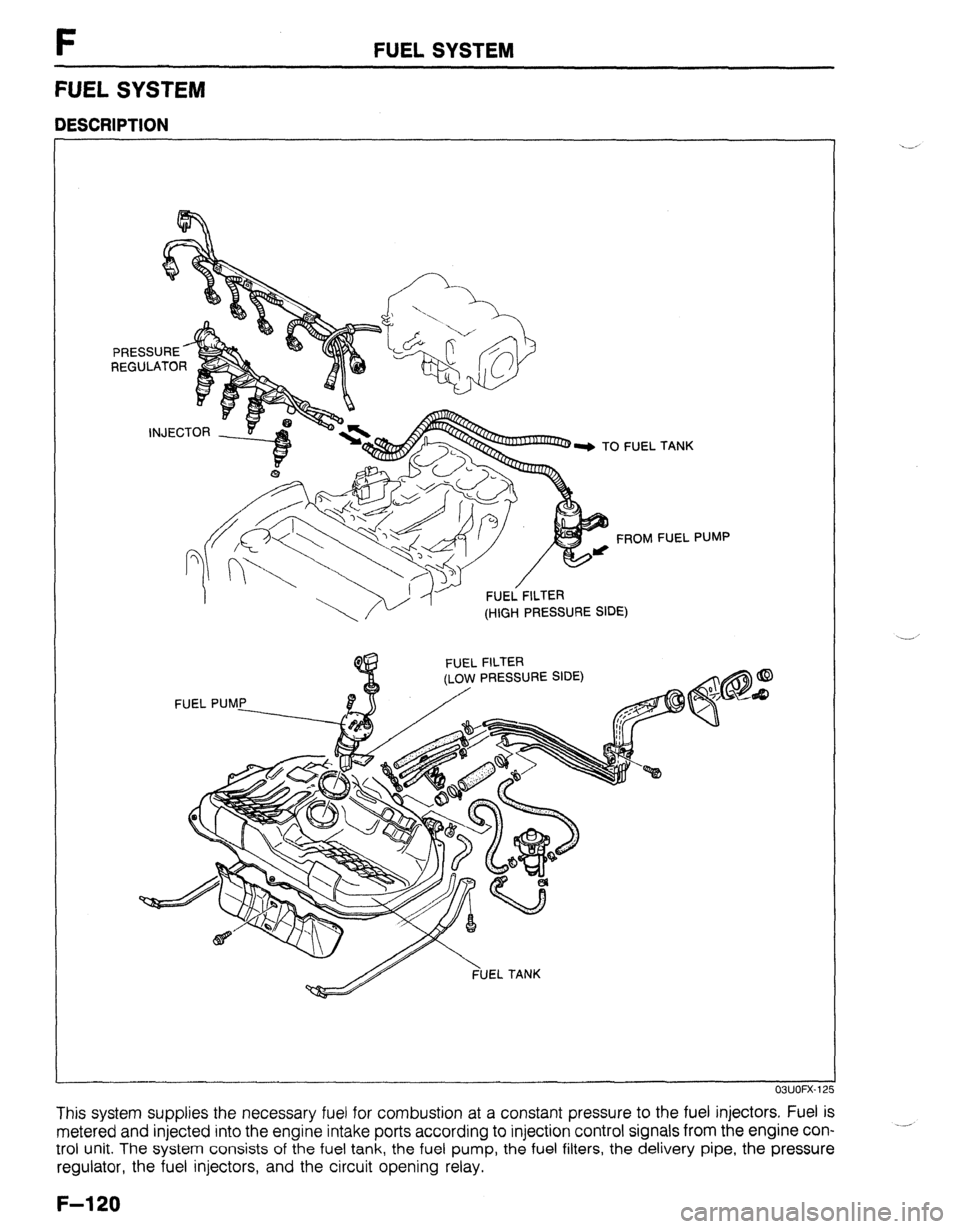
F FUEL SYSTEM
FUEL SYSTEM
DESCRIPTION
FUEL FILTER
(HIGH PRESSURE SIDE) . TANK
FUEL PUMP
PRESSURE SIDE)
OWOFX-12
This system supplies the necessary fuel for combustion at a constant pressure to the fuel injectors. Fuel is
metered and injected into the engine intake ports according to injection control signals from the engine con-
trol unit. The system consists of the fuel tank, the fuel pump, the fuel filters, the delivery pipe, the pressure
regulator, the fuel injectors, and the circuit opening relay. ._*
F-l 20
Page 387 of 1164
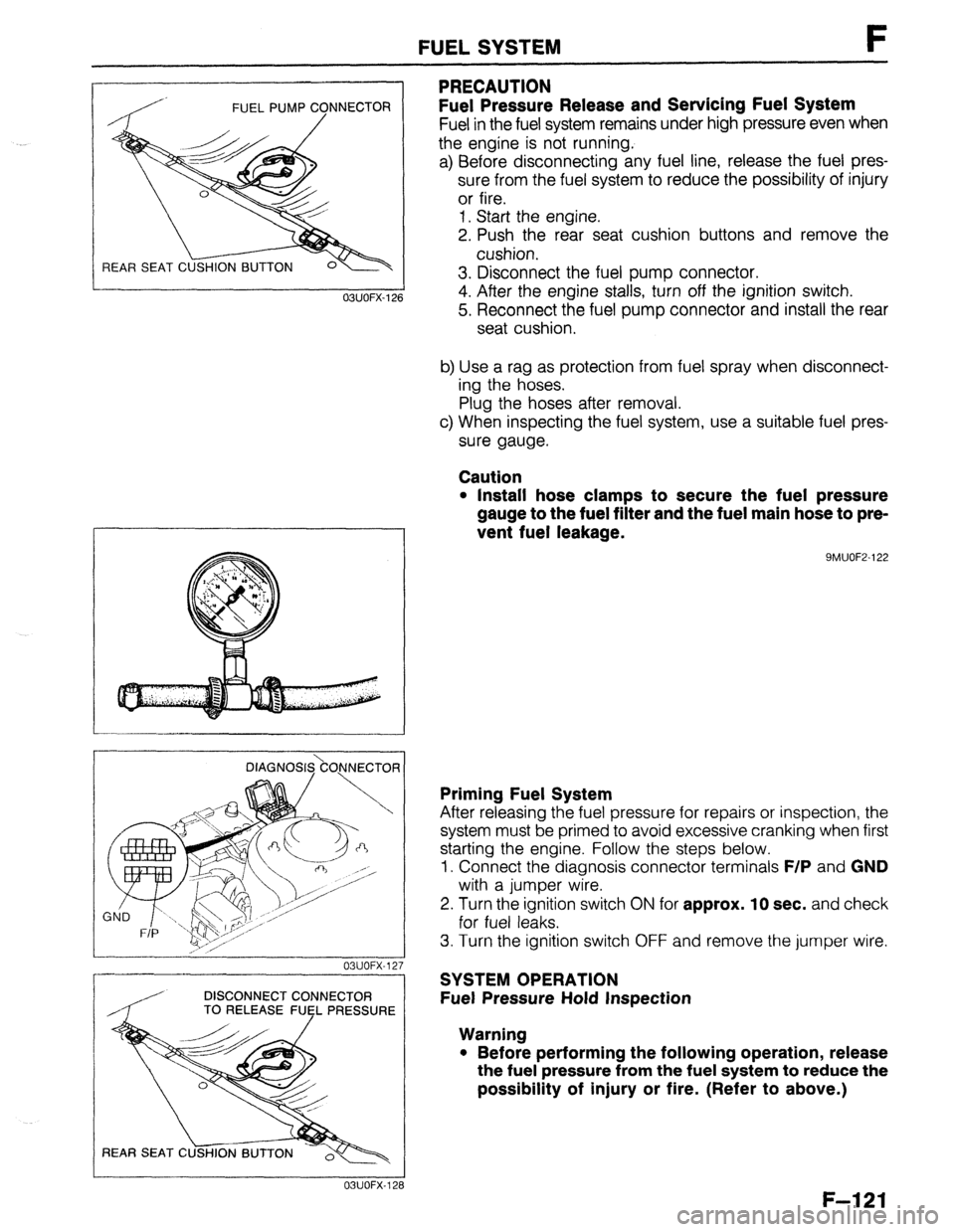
FUEL PUMP CONNECTOR
/
REAR SEAT C
FUEL SYSTEM F
PRECAUTION
Fuel Pressure Release and Servicing Fuel System
Fuel in the fuel system remains under high pressure even when
the engine is not running.
a) Before disconnecting any fuel line, release the fuel pres-
sure from the fuel system to reduce the possibility of injury
or fire.
1. Start the engine.
2. Push the rear seat cushion buttons and remove the
cushion.
3. Disconnect the fuel pump connector.
4. After the engine stalls, turn off the ignition switch.
5. Reconnect the fuel pump connector and install the rear
seat cushion.
b) Use a rag as protection from fuel spray when disconnect-
ing the hoses.
Plug the hoses after removal.
c) When inspecting the fuel system, use a suitable fuel pres-
sure gauge.
Caution
l Install hose clamps to secure the fuel pressure
gauge to the fuel filter and the fuel main hose to pre-
vent fuel leakage.
9MUOF2-122 OBUOFX-126
DlAGNOS&O,NNECTOR
03UOFX-12.
-
DISCONNECT CONNECTOR
/ TO RELEASE FUEL PRESSURE
03UOFX-12;
Priming Fuel System
After releasing the fuel pressure for repairs or inspection, the
system must be primed to avoid excessive cranking when first
starting the engine. Follow the steps below.
1. Connect the diagnosis connector terminals
F/P and GND
with a jumper wire.
2. Turn the ignition switch
ON for approx. 10 sec. and check
for fuel leaks.
3. Turn the ignition switch OFF and remove the jumper wire.
SYSTEM OPERATION
Fuel Pressure Hold Inspection
Warning
l Before performing the following operation, release
the fuel pressure from the fuel system to reduce the
possibility of injury or fire. (Refer to above.)
F-121
Page 388 of 1164
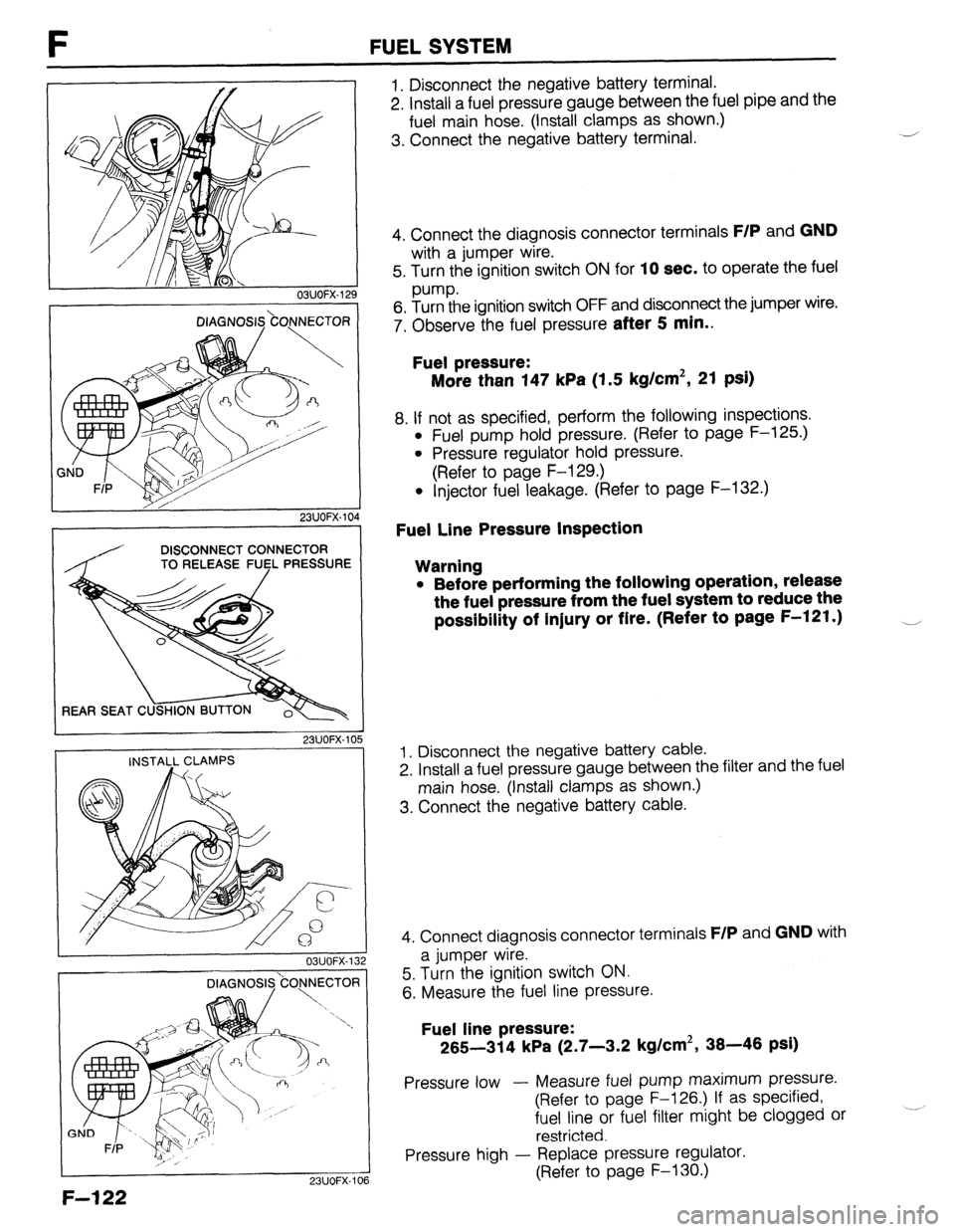
F FUEL SYSTEM
OSUOFX-129
DIAGNOSIS.\CO.NNECTOR j
/, I 23UOFX-104
DISCONNECT CONNECTOR
TO RELEASE FlJsL PRESSURE
L 23UOFX-105
INSTALL CLAMPS
DIAGNOSI$kO)lNECTOfl
I
23UOFX-ll
F-l 22
1. Disconnect the negative battery terminal.
2. Install a fuel pressure gauge between the fuel pipe and the
fuel main hose. (Install clamps as shown.)
3. Connect the negative battery terminal. J
4. Connect the diagnosis connector terminals
F/P and GND
with a jumper wire.
5. Turn the ignition switch ON for
10 sec. to operate the fuel
pump.
6. Turn the ignition switch OFF and disconnect the jumper wire.
7. Observe the fuel pressure
after 5 min..
Fuel pressure:
More than 147 kPa (1.5 kg/cm2, 21 psi)
8. If not as specified, perform the following inspections.
l Fuel pump hold pressure. (Refer to page F-125.)
l Pressure regulator hold pressure.
(Refer to page F-129.)
l Injector fuel leakage. (Refer to page F-132.)
Fuel Line Pressure Inspection
Warning
l Before performing the following operation, release
the fuel pressure from the fuel system to reduce the
possibility of injury or fire. (Refer to page F-121.) __,
1. Disconnect the negative battery cable.
2. Install a fuel pressure gauge between the filter and the fuel
main hose. (Install clamps as shown.)
3. Connect the negative battery cable.
4. Connect diagnosis connector terminals
F/P and GND with
a jumper wire.
5. Turn the ignition switch ON.
6. Measure the fuel line pressure.
Fuel line pressure:
265-314 kPa (2.7-3.2 kg/cm2, 38-46 psi)
Pressure low - Measure fuel pump maximum pressure.
(Refer to page F-126.) If as specified,
fuel line or fuel filter might be clogged or
restricted.
Pressure high - Replace pressure regulator.
(Refer to page F-130.)
Page 390 of 1164
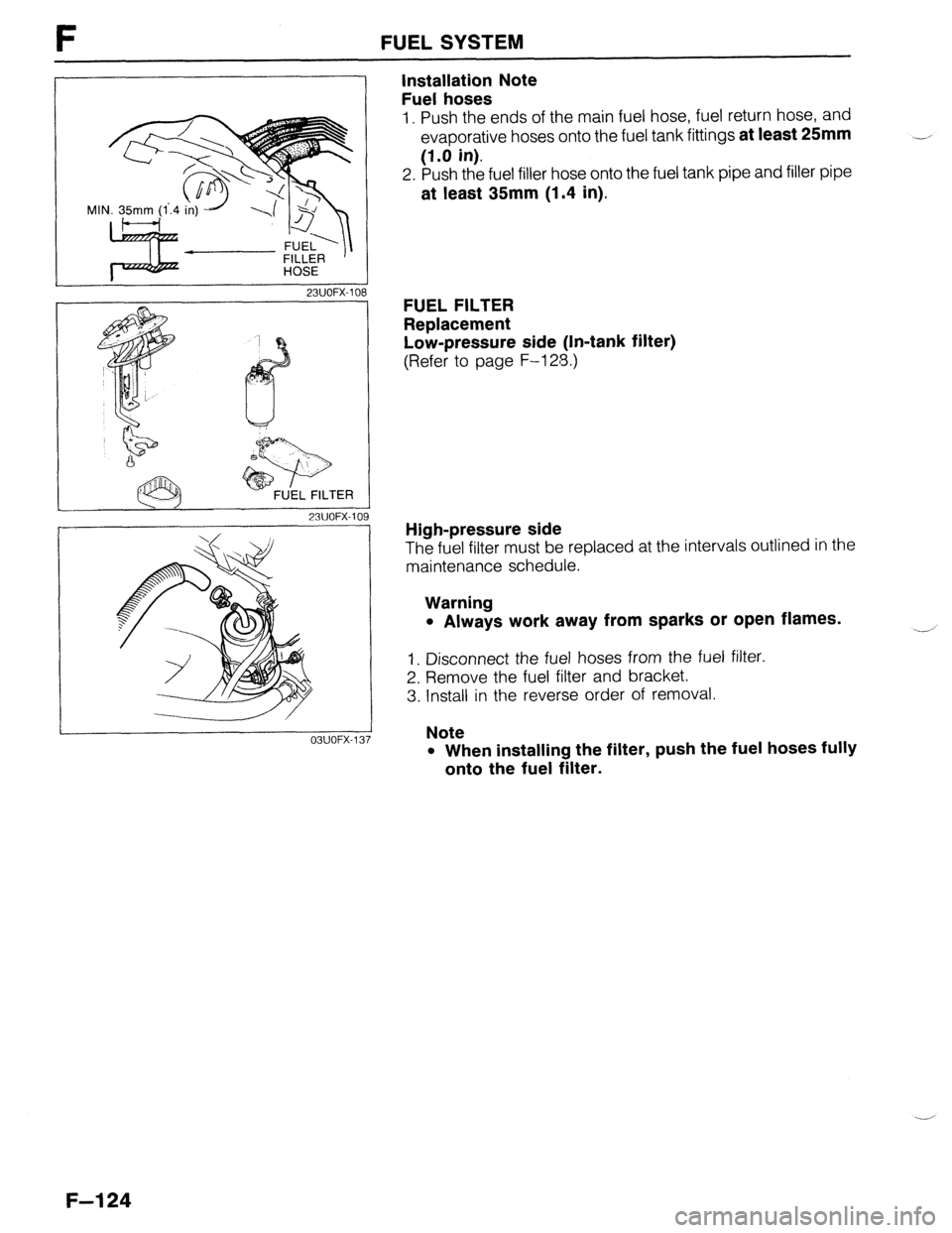
F FUEL SYSTEM
MIN. 35mm (1..4 in) -/
23UOFX-10
NJ
23UOFX-l(
OBUOFX-1:
Installation Note
Fuel hoses
1. Push the ends of the main fuel hose, fuel return hose, and
evaporative hoses onto the fuel tank fittings at least 25mm
(1.0 in).
2. Push the fuel filler hose onto the fuel tank pipe and filler pipe
at least 35mm (1.4 in).
FUEL FILTER
Replacement
Low-pressure side (In-tank filter)
(Refer to page F-128.)
High-pressure side
The fuel filter must be replaced at the intervals outlined in the
maintenance schedule.
Warning
l Always work away from sparks or open flames.
1. Disconnect the fuel hoses from the fuel filter.
2. Remove the fuel filter and bracket.
3. Install in the reverse order of removal.
Note
l When installing the filter, push the fuel hoses fully
onto the fuel filter.
F-l 24
Page 394 of 1164
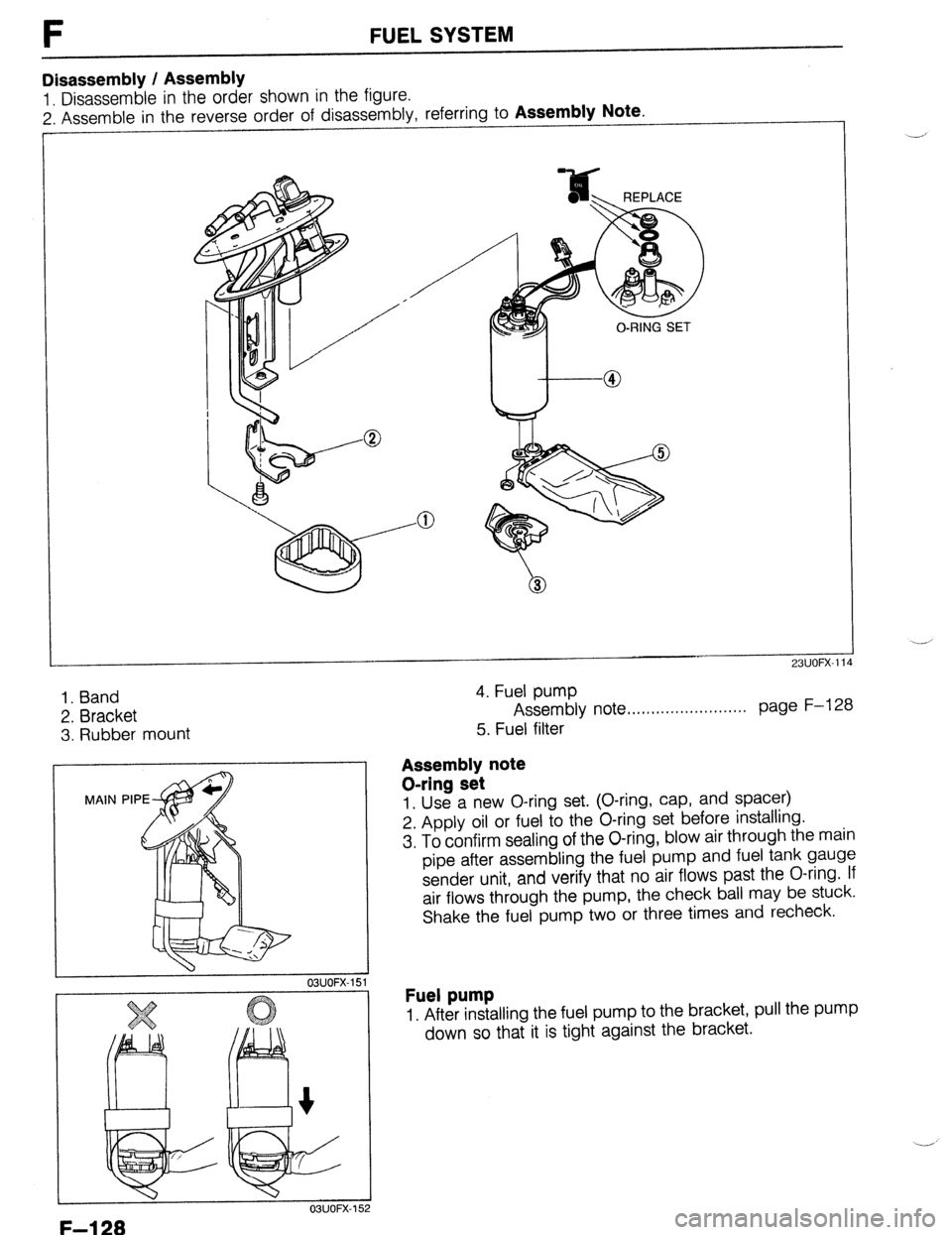
F FUELSYSTEM
Disassembly / Assembly
1. Disassemble in the order shown in the figure.
2. Assemble in the reverse order of disassembly, referring to
Assembly Note
1. Band
2. Bracket
3. Rubber mount
OSUOFX-152
4. Fuel pump
Assembly note ,..........,....,,....,.. page F-l 28
5. Fuel filter
Assembly note
O-ring set
1. Use a new O-ring set. (O-ring, cap, and spacer)
2. Apply oil or fuel to the O-ring set before installing.
3. To confirm sealing of the O-ring, blow air through the main
pipe after assembling the fuel pump and fuel tank gauge
sender unit, and verify that no air flows past the O-ring. If
air flows through the pump, the check ball may be stuck.
Shake the fuel pump two or three times and recheck.
Fuel pump
1. After installing the fuel pump to the bracket, pull the pump
down so that it is tight against the bracket.
F-l 28
Page 395 of 1164

FUEL SYSTEM F
STA
OBUOFX- 15
03UOFX-15
DISCONNECT CONNECTOR
TO RELEASE FUfL PRESSURE
REAR SEAT C
23UOFX-11
INSTALL CLAMPS
CIRCUIT OPENING RELAY
Inspection
Voltage inspection
I, Check voltage between the following terminals and a ground
using a voltmeter.
Ve: Battery voltage
Resistance inspection
1, Check resistance between the terminals using an ohmmeter.
Terminal Resistance (Q)
STA-El 21-43
B-Fc 109-226
B-Fp 00
Replacement
1, Remove the passenger side wall.
2. Disconnect the relay connector.
3. Remove the relay from ECU bracket.
4. Install in the reverse order of removal.
PRESSURE REGULATOR
Inspection
Fuel line pressure
Warning
l Before performing the following operation, release
the fuel pressure from the fuel system to reduce the
possibility of injury or fire. (Refer to page F-121.)
1, Disconnect the negative battery terminal.
2. Connect a fuel pressure gauge between the fuel filter and
the fuel main hose. (Install clamps as shown.)
3. Connect the negative battery terminal.
4. Start the engine and run it at idle.
5. Measure the fuel line pressure.
Fuel line pressure:
206-255 kPa (2.1-2.6 kg/cm2, 30-37 psi)
6. Disconnect the vacuum hose from the pressure regulator
and measure the fuel line pressure.
Fuel line pressure:
265-314 kPa (2.7-3.2 kg/cm2, 36-46 psi)
F-l 29
03UOFX-157
Page 396 of 1164
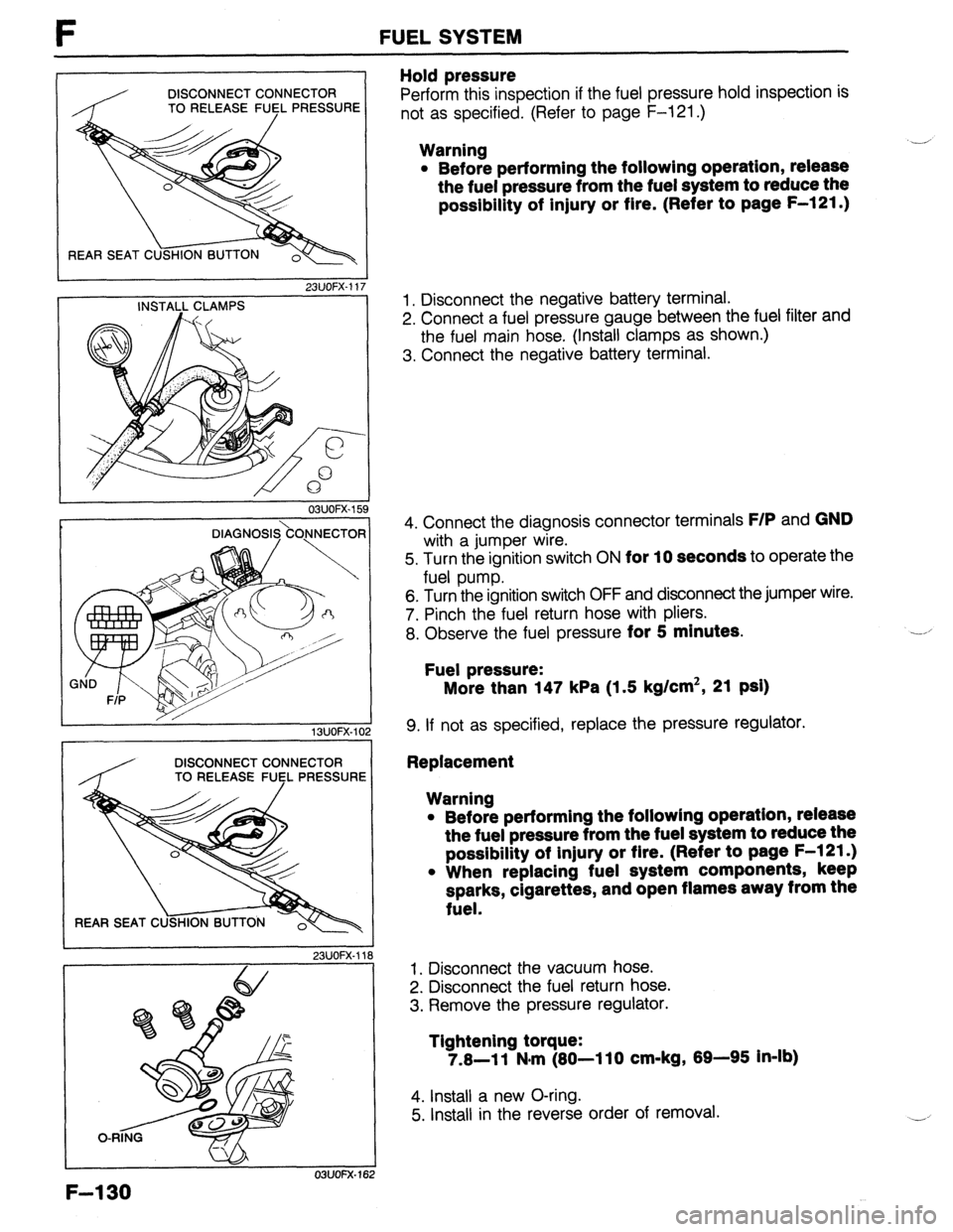
F FUELSYSTEM
DISCONNECT CONNECTOR
TO RELEASE FlJ$L PRESSURE
REAR SEAT C
23UOFX-11
INSTALL CLAMPS 7
03UOFX.I 59
F-l 30
DIAGNOSl&OJNECTOR
/ K
1 SUOFX-10
DISCONNECT CONNECTOR
TO RELEASE
FlJl$L PRESSURE
23UOFX-11
I
Hold pressure
Perform this inspection if the fuel pressure hold inspection is
not as specified. (Refer to page F-121 .)
Warning
l Before performing the following operation, release
the fuel pressure from the fuel system to reduce the
possibility of injury or fire. (Refer to page F-121 .) ,-
1. Disconnect the negative battery terminal.
2. Connect a fuel pressure gauge between the fuel filter and
the fuel main hose. (Install clamps as shown.)
3. Connect the negative battery terminal.
4. Connect the diagnosis connector terminals
F/P and GND
with a jumper wire.
5. Turn the ignition switch ON
for 10 seconds to operate the
fuel pump.
6. Turn the ignition switch OFF and disconnect the jumper wire.
7. Pinch the fuel return hose with pliers.
8. Observe the fuel pressure
for 5 minutes.
Fuel pressure:
More than 147 kPa (1.5 kg/cm2, 21 psi)
9. If not as specified, replace the pressure regulator.
Replacement
Warning
l Before performing the followlng operation, release
the fuel pressure from the fuel system to reduce the
possibility of injury or flre. (Refer to page F-l 21.)
l When replacing fuel system components, keep
sparks, cigarettes, and open flames away from the
fuel.
1. Disconnect the vacuum hose.
2. Disconnect the fuel return hose.
3. Remove the pressure regulator.
Tightening torque:
7.8-11 N#m (80-110 cm-kg, 89-95 In-lb)
4. Install a new O-ring.
5. Install in the reverse order of removal.